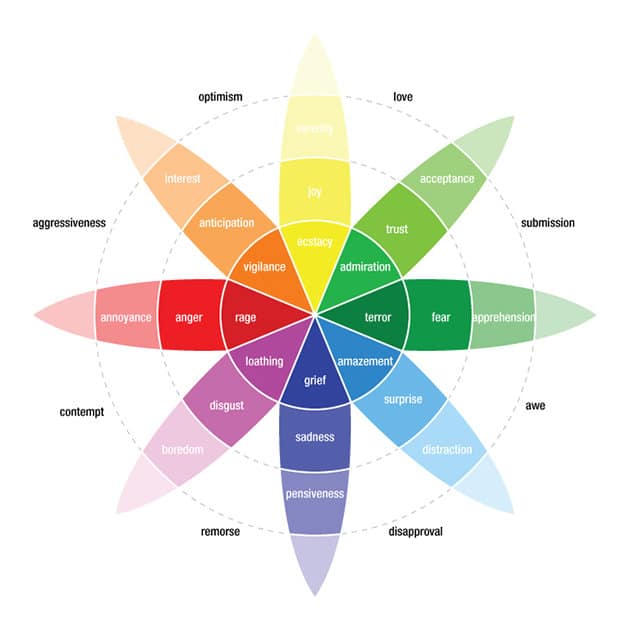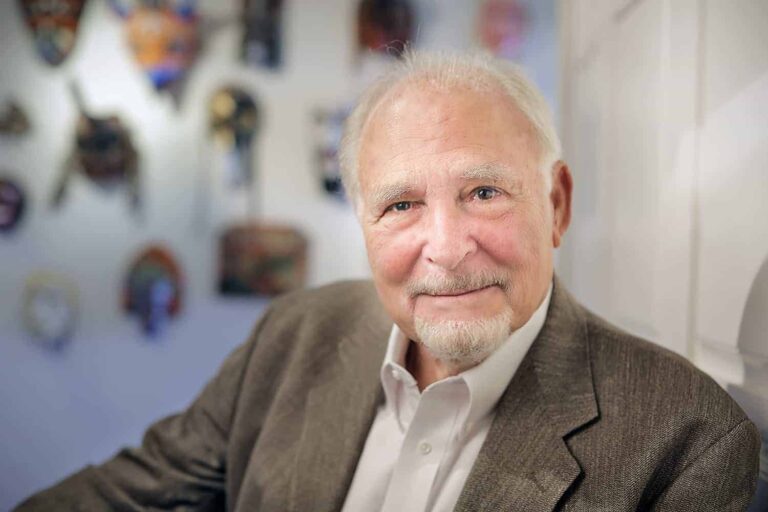Robert Plutchik

Who is Robert Plutchik?
Born on October 21, 1927, Robert Plutchik was a renowned Professor Emeritus with the Albert Einstein College of Medicine and Associate Professor at the University of South Florida. As a psychologist, he got his Ph.D. from Columbia University. His research interests included the study of suicide and violence, the process of psychotherapy, as well as the study of emotions.
Robert Plutchik’s 8 Basic Emotions
In 1980, Robert Plutchik developed the 2D wheel along with a conical 3D version to demystify the psychoevolutionary theory of emotion that he had formulated.
His theory of emotions states that there are eight primary emotions: fear, surprise, disgust, sadness, joy, confidence, and anticipation.
Plutchik asserted that the eight basic emotions could evolve, as they are biologically primitive. In 1980, Plutchik built a visual tool that is widely known as the wheel of emotions to make his psychoevolutionary theory easily understood. The tool listed eight primary emotions in contrasting polar pairs. They are:
- anger vs. fear
- joy vs. sadness
- trust vs. disgust
- surprise vs. anticipation
Plutchik further explained that the Wheel of Emotions tool could be used to switch between the varied intensities that emotions evoke. In other words, the Wheel can be used to identify intense feelings objectively.
According to Plutchik, a study he had conducted revealed that there are 34,000 unique emotions.
However, it is impossible to understand and recognize each of the 34,000 emotions. Plutchik pruned them to only eight emotions to make the concept simpler and easily understandable.
The 3 Elements of the Emotion Wheel
The elements, also known as the 3 main characteristics of the Emotion Wheel, are as follows.
Colors
A unique color within the Emotion Wheel has been used to mark the 8 basic emotions. The rise in the intensity of the emotion leads to a rise in the intensity of the color. But if 2 basic emotions are combined, no color will be assigned to them.
Layers
The emotion wheel consists of a variety of layers and dimensions. The intensity of the emotion and color rises as it approaches the middle of the wheel.
Relations
The wheel stands for the mutual relationships that exist between opposite emotions. When emotions are mixed, their combinations are among the basic emotions. Consequently, all emotions come in contact with one another. This wheel has a total of 24 emotions, including 8 primary emotions and 3 intensities. The primary emotions are:fear, surprise, disgust, sadness, joy, confidence, anticipation
The secondary emotions include love, fear, submission, remorse, rejection, contempt, optimism, and aggressiveness.
Robert Plutchik is a professor emeritus at the Albert Einstein College of Medicine and an adjunct professor at the University of South Florida. He got his Ph.D. from Columbia University. He focuses his research on three areas, including the study of emotions, the study of the psychotherapy process, and the study of suicide and violence.
Secondary emotions are: love, submission, fear, rejection, remorse, contempt, aggressiveness and optimism.
| Basic emotions | Advanced opposite |
| Joy + Anticipation | Deception |
| Trust + Joy | Regret |
| Fear + Confidence | Disdain |
| Surprise + Fear | Alevosía |
| Sadness + Surprise | Optimism |
| Dislike + Sadness | Love |
| Anger + Submission | Dislike |
| Anticipation + Anger | Scare |
The Basic Assumptions of Robert Plutchik’s Wheel of Emotions
There are 10 basic assumptions behind Robert Plutchik’s Wheel of Emotions theory. The assumptions are:
1. Animal and human
Humans and all other mammals have the same basic emotions which are activated in the middle part of the brain.
2. Evolution
During the evolution process, emotions came into being and developed gradually in humans. This process has led to 34,000 various discernible emotions, including the 8 basic emotions.
3. Survival
The 8 basic emotions contribute greatly to human survival, for instance, by evoking emotions such as fear.
4. Basic patterns
Each of the basic emotions has a series of similar and identifiable elements and patterns called prototypes.
5. Basic emotions
The theory names 8 basic emotions shared by humans and other mammals. Those emotions include fear, surprise, disgust, sadness, joy, confidence, and anticipation.
6. Combinations
If the 8 basic emotions come together, the combination produces new emotions. For example, trust and joy can evolve to become love.
7. Constructions
This idea means that emotions are ideas or hypothetical constructions used to describe a certain experience.
8. Opposites
Duality and polar opposites are common in nature. Examples are Fear vs. Anger, Joy vs. Sadness, Anticipation vs. Surprise, and Confidence vs. Disgust.
9. Similarity
Some emotions share common elements.
10. Intensity
Each of the said emotions has degrees ranging from diminished to fairly intense.
Using the Wheel of Emotions

The wheel of emotions is a great tool that helps people to verbalize and clarify their emotions, and also to know the intensity of their feelings. The ability to understand and express emotions is an essential element of emotional intelligence.
People can use this tool to understand their emotions and come to a conclusion on how they feel, decide on issues, resolve disputes, obtain closure, and eventually improve their self-awareness and compassion.
Furthermore, the wheel can be used to explain one’s emotions to people, especially during therapy sessions.
If you can easily give a name to what you feel, it will provide you with a greater sense of control and help you to design a plan to face and resolve issues.
Many organizations employ the wheel or its variations to promote team building, agree on issues, respect each other’s opinions, and develop individual awareness.
All these are expected to lead to a better relationship between workers and improvement in individual skills. After all, both leaders and their employees must have strong emotional intelligence to perform their tasks satisfactorily.
Using the Wheel of Emotion for Work, Life and More
Some of the observations Plutchik had while creating the wheel of emotion was that all animals exhibit varied emotions. Emotion is a complicated subject, and sometimes we find it hard to accept how we feel. Meanwhile, the emotion wheel guides us and explains why we feel in a certain way and how we exhibit those feelings. The emotion wheel is very useful in many facets of an individual’s life, ranging from work to relationship until they come to a conclusion on the things that affect them and move on. This tool ultimately facilitates greater understanding and self-awareness.
Robert Plutchik Quotes
All emotions other than basic emotions are variants of these, occurring in various combinations and mixtures. Robert Plutchik
The concept of an emotion applies to all evolutionary levels and all animals including human beings.
Primary emotions have opposites and each emotion can exist with varying degrees of intensity.
An emotion is not simply an emotional state, an emotion is a complex chain of connected events. The chain begins with a stimulus that includes feelings, physiological changes, impulses and behaviors.
Feelings do not manifest in isolation.
Emotions are activated in an individual when survival issues arise. The effect of this state is to create an interaction between the individual and the event or stimulus that caused the emotion.
References
Plutchik, Robert (1980), Emotion: Theory, research, and experience: Vol. 1. Theories of emotion 1, New York: Academic
Rueda de emociones: https://commons.wikimedia.org/wiki/File:Rueda-Plutchik.svg.
Scherer, K. R., Shuman, V., Fontaine, J. R., & Soriano, C. (2013). The GRID meets the Wheel: Assessing emotional feeling via self-report. Components of emotional meaning: A sourcebook, 281-298.






